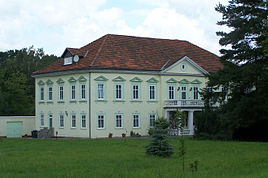Marienthal (Bad Liebenstein)
|
Marienthal
City of Bad Liebenstein
Coordinates: 50 ° 48 ′ 44 ″ N , 10 ° 19 ′ 55 ″ E
|
|
|---|---|
| Height : | 280 m above sea level NN |
| Postal code : | 36448 |
| Area code : | 036961 |
|
Location of Marienthal in Bad Liebenstein
|
|
|
Marienthal Castle
|
|
Marienthal is a settlement belonging to the Schweina district of the city of Bad Liebenstein in the Wartburg district in Thuringia.
location
Marienthal is located in the southern part of the Schweina district on Landesstraße 1027. To the west of the district is Barchfeld with a connection to the Bundesstraße 19 and to the northwest Bad Liebenstein .
history
In the Middle Ages, the area south of Schweina belonged to the Wenigenschweina settlement (first mentioned in 1330). At the end of the 15th century, an estate was built there that belonged to the Lords of Rexrodt. Around 1558, Claus von Wechmar bought the estate, and he probably ordered the construction of a castle-like mansion in the Renaissance style . The Prussian colonel Ludwig Anton von Wechmar (1712–1787) - a hussar general of Frederick the Great during the Seven Years' War , was born in the castle. The estate was offered for sale in 1716 and came to the Liebenstein family of fishermen . Since this family in Liebenstein had their own property, the old castle fell into disrepair due to structural damage and neglect.Only one heir, the Meiningen forester Friedrich von Fischern, invested in the maintenance of the building from 1800, and in 1808 a side building was a new building Completed, on the advice of the builders involved, the old mansion was also demolished in 1812 and replaced by a new building.
The von Fischern family belonged to the landed gentry in the Duchy of Saxony-Meiningen and in 1815 was entrusted with the administration of the ducal forests by the regent, Duchess Louise Eleonore . The constant absence from their estate in Wenigenschweina led to the decision to lease the estate for a longer period of time. The Herzoglich Meiningische Finanzkammer took over the estate in 1833 and renamed it. At the request of the now reigning Duke Bernhard Erich Freund , it was renamed Marienthal after his wife Marie (from Hessen-Kassel).
The property adjacent to the Marienthaler Schlösschen had been the site of a copper smelter since the 16th century, which was about 500 meters south on the banks of the Schweina. This company was acquired in 1853 by the industrialist Andreas Ziegler from Ruhla and a business partner. On the course of the Schweina river, an extensive factory for the manufacture of knives, small iron and brass goods was built within a few years. A successor to the company's founders acquired the Marienthaler Schlösschen as a residence in 1892. In the area up to the outskirts of Schweina there were other industrial companies and on the edge of the valley a small factory workers' settlement called Marienthal.
The Otto Reum family, based in Barchfeld, owned the Pallas works and ran a small gardening business in Marienthal because of their private inclination, as the wife was a flower lover. The Auerhof Inn was built opposite the nursery in 1865. Due to the lack of a license, the restaurant was closed in 1948, but was allowed to continue as a guesthouse until 1968. In 1998 the re-inauguration was celebrated.
The "Marienthaler Krankenhaus" built in 1908 was initially a "surgical clinic", later a children's clinic and maternity ward. It was headed by chairman as chief physician in the 1960s.
In the GDR era, the VEB Lux Werke Marienthal (successor to the nationalized Lux-Werke) was located in the district , this company later became part of VEB Solidor Marienthal, a part of VEB United Metalware Breitungen.
After reunification in 1990, the metal processing plants in the Marienthal were closed. A large part of the up to 100 year old factory buildings was demolished and the area around the castle is now an industrial wasteland. The last industrial ruins of the Lux-Werke were dismantled by mid-2012 and the cleared areas were redeveloped as commercial sites. One of the striking buildings in Marienthal was a Wilhelminian-style factory owner's villa, which was also demolished when the industrial wasteland was demolished.
A small residential estate with a connecting road to Bad Liebenstein was built at the Marienthaler Wäldchen.
Web links
- Location portrait at www.froebelweb.org (English)
Individual evidence
- ↑ Junkers grave in the Marienthaler grove.
- ^ Company R. & O. Lux, Metallwaren- und Maschinenfabrik AG Marienthal - Bad Liebenstein.
- ↑ Ludwig Heller.
- ^ Villa Karl Heller.
- ↑ Auerhof.
- ↑ Mewa-Lux Schweina: Handover of the renovated site. on: insuedthueringen.de , accessed on October 25, 2012.
literature
- Ludwig Hertel: Marienthal. In: Paul Lehfeldt , Georg Voss : Architectural and art monuments of Thuringia. Duchy of Saxony-Meiningen. Volume 1, section 2 = booklet 35 and 36: Meiningen district. District court districts Salzungen and Wasungen. Gustav Fischer, Jena 1910, p. 88 .
- Marienthal. In: Between Ruhla, Bad Liebenstein and Schmalkalden. Results of the local history inventory in the areas of Ruhla and Schmalkalden (= values of our homeland . 48). Akademie-Verlag, Berlin 1989, ISBN 3-05-000378-2 , pp. 94-95.
- Eduard Fritze: History about Bad Liebenstein, Schweina, Steinbach and Atterode. Emphasis. Elch Verlag, Bad Liebenstein 1999, ISBN 3-933566-09-6 .
- Edith Raddatz: The field names of Schweina (after Erich Oeckel's notes from 1769) . In: Altensteiner Blätter. Yearbook . 1993, ZDB -ID 1432089-7 , p. 64-81 .
- Edith Raddatz: 160 years of Marienthal 1833–1993 . In: Altensteiner Blätter. Yearbook . 1993, p. 83-85 .
- Roland Geißler : hiking guide to Bad Liebenstein and the Inselsberg. Hikes and bike tours between Bad Salzungen, Ruhla, Eisenach, Trusetal, Brotterode and the Rennsteig. Rockstuhl, Bad Langensalza 2007, ISBN 978-3-938997-79-6 .




